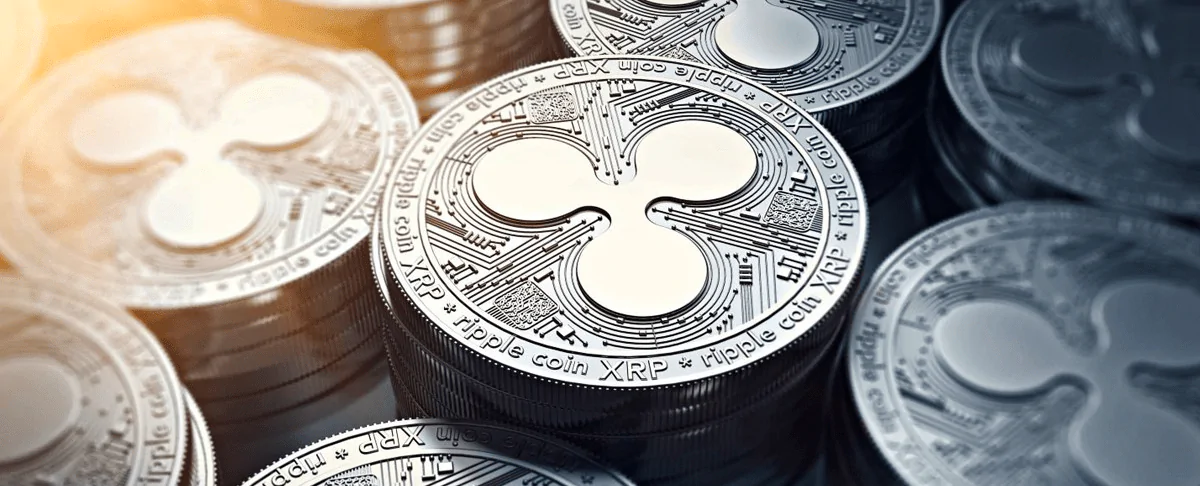As of July 2025, over 37 million unique cryptocurrencies had been created. This suggests that the cryptocurrency market is overheated.
16.05.2022

Every day cryptocurrencies enter our daily life more and more. New coins, which you simply do not have time to keep track of, appear in circulation at a rapid pace. But, for sure, most of you have heard about the most popular of them — such as Bitcoin, Ethereum, Litecoin, Tether, Monero, Tron, Ripple, etc. And, if much has been written about bitcoin, then about other coins much less often. Therefore, we would like to tell in this article about the Ripple cryptocurrency, its history of appearance, key features, the principle of operation, mining and much more.
What is Ripple?
Ripple (XRP) is a payment protocol that uses the blockchain to process international money transfers, making them much more efficient. The protocol has support for tokens that represent conventional fiat money, cryptocurrencies, commodities such as gold for example, as well as various assets that are traded on exchanges.
Initially, the purpose of creating Ripple was to develop an alternative method in banking, and not to replace fiat or completely replace the entire banking system.
The XRP consensus mechanism that confirms transactions is not the same as other cryptocurrencies have. It is designed in such a way that when making a transaction in Ripple, only a small fraction of XRP is taken into account as a commission per user. Transaction confirmation occurs almost instantly, without charging any double costs.
Global financial giants such as UniCredit, UBS, Santander use the Ripple consensus protocol in their calculations, which confirms its reliability and efficiency. In addition, ripple is available to ordinary users and they can easily purchase it on various sites and use it for everyday financial calculations.
Ripple is a kind of proxy that can confirm the transaction between two parties in real time and track it in real time as well.
History of creation
In 2004, Canadian programmer Ryan Fugger created the RipplePay money transfer platform. The main goal of the project was to create a decentralized payment system. In 2005, Fugger managed to launch the first integration, which was called RipplePay.com, but failed to achieve wide popularity. Therefore, Ryan decided to redesign his platform.
In 2011, Fugger transferred part of the management of his company to American programmer Jed McCaleb, who in turn invited David Schwartz and Arthur Britto to the company. With such a company, they redesigned and developed a faster and more energy-efficient system compared to bitcoin. And already in 2012, the OpenCoin company was created. An entrepreneur from America, Chris Larsen, was appointed CEO, at the same time, the author of the first concept, Ryan Fugger, left the project.
Soon, the XRP Ledger consensus registry was also developed and launched, with the goal of improving or even replacing the world famous SWIFT.
In 2013, OpenCoin changed its name to Ripple Labs, Inc. In the same year, the XRP cryptocurrency was launched. Later, Jed McCaleb also leaves the company and starts his new project Stellar. However, to date, he still owns billions of Ripple coins.
For 5 years (from 2014 to 2019), Ripple Labs Inc. has focused its attention and main forces on the banking market. The first bank, Fidor Bank, located in Munich, was connected to the platform. After some time, banks from the USA, Cross River Bank and KBC Bank, as well as the well-known Earthport payment service, joined this technology.
Since 2021, the Ripple protocol has been used for international payments between the United States and the United Kingdom, as well as between South Korea and Japan. In the same year, the Ripple system was integrated into one of the largest banks of the National Bank of Saudi Arabia.
Today the company is developing rapidly. Ripple Labs, Inc. has received a BitLicense license from the authorities of the state of New York, USA. The company has physical offices in the USA, Great Britain, Luxembourg, Singapore, Mumbai. In some countries of the world there are also virtual representative offices of Ripple Labs, Inc.
How the XRP cryptocurrency works?
There is no blockchain in Ripple, such as everyone knows and imagines it. That is, in the ripple blockchain system, it does not perform the function of a chain of closed blocks, as it is in bitcoin, for example. Here, the blockchain is more like a database that is distributed among network nodes, the speed of which is simply amazing. Throughput is almost one and a half thousand transactions per second.
So, the work of the Ripple ecosystem is based on a registry (distributed database), which stores information about crypto wallets, the number of ripple coins each user has, transactions that were carried out when using this system.
The operation of the registry, as well as the confirmation of all transactions, are performed when the Ripple Protocol Consensus Algorithm (RPCA) is reached. This protocol allows updating the registry every couple of seconds. The registry has copies, they are located on network nodes, that is, servers.
If everything became clear with the internal part, then Ripple interacts with the outside world through gateways. The process of conducting a transaction comes down to the fact that the user must transfer the amount of the exchange transaction to this gateway by any convenient payment method, whether it is a bank card or a payment system. Further, in the gateway, the currency entered by the user is converted to another, if necessary. This exchange will be carried out at the most favorable rate. After completing these steps, the gateway redirects the request to the system.
Step by step, the whole work of Ripple will look something like this:
- The user, and this can be either an ordinary person or a banking structure, or another large financial institution, deposits the transaction amount into the gateway and thereby creates a request: «Exchange of the deposited amount to account B».
- Next, this transaction request is sent from the gateway to the system.
- The application is distributed in the system to the node (server) that can execute it.
- If one of the servers becomes the initiator of the application, the rest look at it and decide whether to add this application to the registry or not, in other words, this application goes through the stage of inclusion in the list of «candidates» for entry in the registry.
- The lists of «candidates» are formed in such a way that the «candidates», that is, transactions, are as similar as possible to each other. As soon as this process is carried out, it is considered that the system has reached a consensus and this entire list is transferred to the registry.
- A transaction is considered completed as soon as all information about it is included in the registry, and all copies of the registries are sent to all network servers.
It would seem that this is a very long process, but thanks to super technologies, such transactions are carried out almost at lightning speed, literally in a matter of seconds.
Advantages and disadvantages of XRP
When studying any cryptocurrency, it is important to know about its advantages and disadvantages. Ripple is no exception, so let’s take a closer look at the functional features of this ecosystem.
Advantages:
- Speed. Ultra-fast confirmation of transactions, which occurs within 4-5 seconds. For comparison: regular bank applications are completed over several days, and it takes from several minutes to half an hour to verify the exchange of bitcoins, sometimes it can be more.
- Low commissions. On the Ripple network, the fee is 0.0001 XRP, which is not even worth 1 cent at the current exchange rate.
- Versatility. Although the Ripple platform ecosystem has its own XRP coin, it can also process transactions with other cryptocurrencies, fiat money, and even commodities such as gold.
- Mass application. The main goal of Ripple is to become the same global payment system as SWIFT, the functions of which will be used by the largest financial institutions in the world. Already, Ripple is used by large banks and financial organizations to conduct transactions, which indicates the trust and recognition of this system.
Disadvantages:
- Partial centralization. Although Ripple positions itself as a completely decentralized network, in fact it is not, because there is still a list of transaction validators that it relies on, and this is contrary to the philosophy of complete decentralization.
- Current SEC litigation. In 2020, a lawsuit was filed against Ripple by the Securities and Exchange Commission (SEC), which concluded that since Ripple can be issued at any time and as much as you like, they should be registered as securities, not digital coins. Ripple denied this accusation.
- Pre-mined coins. And now, after 2 years of litigation, the story began to gain new momentum, because the American court ordered the SEC to provide such a document that will bring this story closer to the denouement. And while any litigation with the company lasts, it cannot be considered absolutely positive.
- General risk. While the cryptocurrency industry is too young and many countries have not yet adopted legislation regarding the regulation of virtual currencies, there are possible risks.
Ripple Mining
Since the XRP emission is equal to 100 billion coins and they were immediately generated by the developers at the very first launch of the coin, the question of mining disappears by itself. In accordance with the rules of the Ripple protocol, no changes in the number of coins are planned, and the entire flow is controlled by Ripple.
About 60% of all tokens are held by the development team, the remaining 40% of XRP is held by ordinary users. This causes a lot of criticism among analysts, since the company itself owns more than half of the coins, which is very rare in the crypto world.
In turn, Ripple announced the freezing of its 88% of the coins, the rest of the coins are regularly released to the market through sales.
But still, many owners of Ripple and other cryptocurrencies still have fears that the company may release all its reserves at the same time, which will provoke a fall in the rate.
How to buy Ripple?
You can now buy a ripple on a variety of cryptocurrency exchanges and online exchangers, this can be done both for fiat currency and in exchange for another cryptocurrency. You can also use the Ripple XRP Ledger platform as a decentralized exchange that allows you to trade coins directly.
Please note that due to the SEC and Ripple litigation, some exchanges have suspended XRP sales. Often they only allow you to trade coins using their platforms. And if you need to buy a ripple cryptocurrency for fiat money, exchange it for another cryptocurrency and at the same time you do not want to wait long, then use the services of a cryptocurrency exchanger, while paying attention to the customer reviews of the service. And if you need to buy a ripple cryptocurrency for fiat money, exchange it for another cryptocurrency and at the same time you do not want to wait long, then use the services of a cryptocurrency exchanger, while paying attention to the customer reviews of the service. One of these crypto exchangers is Buycoin.online, which will automatically process your applications at the most favorable rate.
Nevertheless, it is you who make the final decision and you know better how to manage your assets.
Where to store XRP cryptocurrency?
Like any other cryptocurrency, Ripple should be stored in a safe place in order to avoid malware or hackers. To do this, you can use both cryptocurrency exchanges and special wallets.
The peculiarity of storing ripple on exchanges is that you have quick access to your coins, but at the same time the access key to the vault is not stored by you, but on the exchange servers, which may well be hacked by hackers.
As for saving crypto on wallets, this option will be more reliable, since there are many different types of wallets themselves and keys to them. They can be either built into a mobile phone, or stored on some kind of portable flash drive, or even be paper.
Of all the listed types, cold (hardware) wallets deserve trust, the key to opening which is stored offline, and connects to the network only when a transaction needs to be made. Although this wallet is considered the most reliable, it is rarely popular among XRP holders.
The top wallets for storing Ripple among crypto owners are the following: Toast Wallet, Edge, Jaxx, Coinbase Wallet.
It is also worth considering that with the growing popularity of the XRP cryptocurrency, the list of wallets that support this coin is also increasing. So in the near future, the list of crypto wallets may increase significantly.
Prospects and forecasts for the development of the Ripple project
In recent years, XRP has been steadily holding the bar and is among the TOP-10 crypto coins in terms of capitalization. Despite all the negative reviews of various cryptanalysts, experts, litigations, users are more and more attracted to Ripple and they want to purchase it for their crypto portfolio, seeing it as a great perspective.
The big players on the financial markets confirm the guesses of ordinary users in the prospects of Ripple. Thus, the assets that were invested on the basis of Ripple attracted about 90 million US dollars, while polkadot — 75 million US dollars, and Litecoin only crossed the mark of 25 million US dollars. In addition, Japan’s largest financial conglomerate SBI Holdings has launched a crypto fund that also holds XRP. Such interest of many investors only speaks of confidence in the prospects of the project, and this can directly play a significant role in changing the rate of the coin.
Regardless of financial regulators, many experts and analysts predict a Ripple exchange rate of over $12 per coin. Whether it will be so or not, we will be able to check in the coming months or years.




